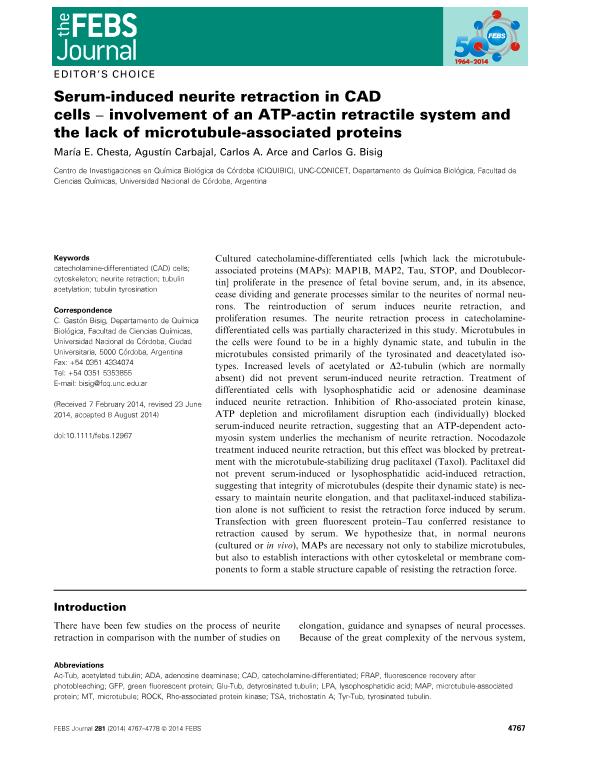Mostrar el registro sencillo del ítem
dc.contributor.author
Chesta, María Eugenia

dc.contributor.author
Carbajal, Agustin

dc.contributor.author
Arce, Carlos Angel

dc.contributor.author
Bisig, Carlos Gaston

dc.date.available
2018-01-03T14:29:47Z
dc.date.issued
2014-10
dc.identifier.citation
Bisig, Carlos Gaston; Arce, Carlos Angel; Carbajal, Agustin; Chesta, María Eugenia; Serum-induced neurite retraction in CAD cells – involvement of an ATP-actin retractile system and the lack of microtubule-associated proteins; Wiley Blackwell Publishing, Inc; Febs Journal; 281; 21; 10-2014; 4767-4778
dc.identifier.issn
1742-464X
dc.identifier.uri
http://hdl.handle.net/11336/32114
dc.description.abstract
Cultured catecholamine-differentiated cells [which lack the microtubule-associated proteins (MAPs): MAP1B, MAP2, Tau, STOP, and Doublecortin] proliferate in the presence of fetal bovine serum, and, in its absence, cease dividing and generate processes similar to the neurites of normal neurons. The reintroduction of serum induces neurite retraction, and proliferation resumes. The neurite retraction process in catecholamine-differentiated cells was partially characterized in this study. Microtubules in the cells were found to be in a highly dynamic state, and tubulin in the microtubules consisted primarily of the tyrosinated and deacetylated isotypes. Increased levels of acetylated or Δ2-tubulin (which are normally absent) did not prevent serum-induced neurite retraction. Treatment of differentiated cells with lysophosphatidic acid or adenosine deaminase induced neurite retraction. Inhibition of Rho-associated protein kinase, ATP depletion and microfilament disruption each (individually) blocked serum-induced neurite retraction, suggesting that an ATP-dependent actomyosin system underlies the mechanism of neurite retraction. Nocodazole treatment induced neurite retraction, but this effect was blocked by pretreatment with the microtubule-stabilizing drug paclitaxel (Taxol). Paclitaxel did not prevent serum-induced or lysophosphatidic acid-induced retraction, suggesting that integrity of microtubules (despite their dynamic state) is necessary to maintain neurite elongation, and that paclitaxel-induced stabilization alone is not sufficient to resist the retraction force induced by serum. Transfection with green fluorescent protein–Tau conferred resistance to retraction caused by serum. We hypothesize that, in normal neurons (cultured or in vivo), MAPs are necessary not only to stabilize microtubules, but also to establish interactions with other cytoskeletal or membrane components to form a stable structure capable of resisting the retraction force.
dc.format
application/pdf
dc.language.iso
eng
dc.publisher
Wiley Blackwell Publishing, Inc

dc.rights
info:eu-repo/semantics/openAccess
dc.rights.uri
https://creativecommons.org/licenses/by-nc-sa/2.5/ar/
dc.subject
Catecholamine-Differentiated (Cad) Cells
dc.subject
Cytoskeleton
dc.subject
Neurite Retraction
dc.subject
Tubulinacetylation
dc.subject
Tubulin Tyrosination
dc.subject.classification
Otras Ciencias Biológicas

dc.subject.classification
Ciencias Biológicas

dc.subject.classification
CIENCIAS NATURALES Y EXACTAS

dc.title
Serum-induced neurite retraction in CAD cells – involvement of an ATP-actin retractile system and the lack of microtubule-associated proteins
dc.type
info:eu-repo/semantics/article
dc.type
info:ar-repo/semantics/artículo
dc.type
info:eu-repo/semantics/publishedVersion
dc.date.updated
2017-12-29T14:12:50Z
dc.journal.volume
281
dc.journal.number
21
dc.journal.pagination
4767-4778
dc.journal.pais
Reino Unido

dc.journal.ciudad
Londres
dc.description.fil
Fil: Chesta, María Eugenia. Consejo Nacional de Investigaciones Científicas y Técnicas. Centro Científico Tecnológico Conicet - Córdoba. Centro de Investigaciones en Química Biológica de Córdoba. Universidad Nacional de Córdoba. Facultad de Ciencias Químicas. Centro de Investigaciones en Química Biológica de Córdoba; Argentina
dc.description.fil
Fil: Carbajal, Agustin. Consejo Nacional de Investigaciones Científicas y Técnicas. Centro Científico Tecnológico Conicet - Córdoba. Centro de Investigaciones en Química Biológica de Córdoba. Universidad Nacional de Córdoba. Facultad de Ciencias Químicas. Centro de Investigaciones en Química Biológica de Córdoba; Argentina
dc.description.fil
Fil: Arce, Carlos Angel. Consejo Nacional de Investigaciones Científicas y Técnicas. Centro Científico Tecnológico Conicet - Córdoba. Centro de Investigaciones en Química Biológica de Córdoba. Universidad Nacional de Córdoba. Facultad de Ciencias Químicas. Centro de Investigaciones en Química Biológica de Córdoba; Argentina
dc.description.fil
Fil: Bisig, Carlos Gaston. Consejo Nacional de Investigaciones Científicas y Técnicas. Centro Científico Tecnológico Conicet - Córdoba. Centro de Investigaciones en Química Biológica de Córdoba. Universidad Nacional de Córdoba. Facultad de Ciencias Químicas. Centro de Investigaciones en Química Biológica de Córdoba; Argentina
dc.journal.title
Febs Journal

dc.relation.alternativeid
info:eu-repo/semantics/altIdentifier/doi/http://dx.doi.org/10.1111/febs.12967
dc.relation.alternativeid
info:eu-repo/semantics/altIdentifier/url/http://onlinelibrary.wiley.com/doi/10.1111/febs.12967/abstract
Archivos asociados
